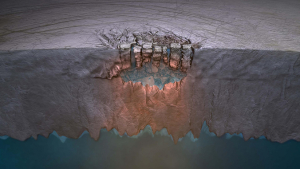
Beneath a miles-thick icy crust, Jupiter’s moon Europa likely has a saltwater ocean that may be one of the best places to look for life beyond Earth. Researchers in the Hawaiʻi Institute of Geophysics and Planetology (HIGP) at the University of Hawaiʻi at Mānoa were awarded $1.8 million by NASA to predict where they may have the best chance of accessing the ocean and possibly finding life.
On Europa, liquid from the ocean may be exposed at the surface, or actively escape into space through plumes of vapor and ice particles. Such activity could also bring with it samples of microbial life that may inhabit the ocean. Sarah Fagents, researcher in HIGP at the UH Mānoa School of Ocean and Earth Science and Technology (SOEST), is leading the effort via the Europa Clipper, the mission to Europa launched by NASA in October.

“This precursor work will provide critical context to enable more efficient analysis of Clipper data by the science community and will help generate discoveries and new questions that will feed into the planning of mission observations,” said Fagents. “This will maximize the science return during the lifetime of the Europa Clipper, which is limited due to the intense radiation it will experience around this moon.”
After traversing the solar system for nearly six years, Europa Clipper will reach Jupiter, orbit the planet, and conduct nearly 50 close flybys of Europa.
Clues from chaos
The team’s research will focus on what is referred to as Europa’s chaos terrains. These are highly fractured and disrupted areas of the moon’s surface where blocks of ice appear to have broken off, drifted and refrozen to the surface. Previous research has indicated that liquid water either rises directly from the ocean to the subsurface or forms by the melting of salty ice at shallow depths, creating massive lakes inside the moon’s frozen crust. Over time, the ice directly above these lakes collapses, splintering into floating fragments that rotate, raft and resettle into all kinds of configurations.
“With the upcoming work, we will assess the feasibility of different chaos formation models, determine the potential for exposure of interior and/or ocean materials at the surface, develop techniques for efficient analysis of Clipper data, and evaluate where best to look for signs of habitability exposed at the surface,” said Fagents. “I’m excited to see what’s ahead.”
Fagents’ three-year project includes HIGP researchers Shuai Li, Gwendolyn Brouwer and Lauren Schurmeier; and collaborators from four other institutions (NASA Goddard Space Flight Center, Woods Hole Oceanographic Institute, the University of Texas at Austin, and Johns Hopkins Applied Physics Lab).
–By Marcie Grabowski

